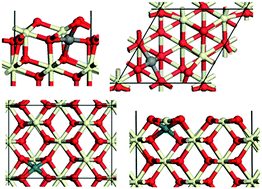Enhanced oxygen vacancy formation in ceria (111) and (110) surfaces doped with divalent cations
Abstract
With increasing interest in new catalytic materials based on doping of cerium dioxide with other metal

* Corresponding authors
a
Tyndall National Institute, University College Cork, Lee Maltings, Cork, Ireland
E-mail:
michael.nolan@tyndall.ie
With increasing interest in new catalytic materials based on doping of cerium dioxide with other metal

 Please wait while we load your content...
Something went wrong. Try again?
Please wait while we load your content...
Something went wrong. Try again?
M. Nolan, J. Mater. Chem., 2011, 21, 9160 DOI: 10.1039/C1JM11238D
To request permission to reproduce material from this article, please go to the Copyright Clearance Center request page.
If you are an author contributing to an RSC publication, you do not need to request permission provided correct acknowledgement is given.
If you are the author of this article, you do not need to request permission to reproduce figures and diagrams provided correct acknowledgement is given. If you want to reproduce the whole article in a third-party publication (excluding your thesis/dissertation for which permission is not required) please go to the Copyright Clearance Center request page.
Read more about how to correctly acknowledge RSC content.
 Fetching data from CrossRef.
Fetching data from CrossRef.
This may take some time to load.
Loading related content
